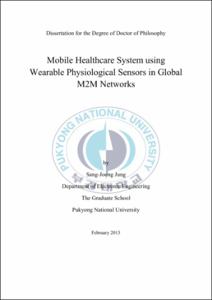웨어러블 생체센서를 이용한 글로벌 M2M 네트워크 모바일 헬스케어 시스템
- Alternative Title
- Mobile Healthcare System using Wearable Physiological Sensors in Global M2M Networks
- Abstract
- 본 논문에서는 접근성이 유연하고 확장성이 보장된 6LoWPAN을 이용한 글로벌 네트워크 기반의 모바일 헬스케어 시스템을 구현하였다. 제안된 시스템은 IPv6 주소 메커니즘을 사용한 계층적 구조의 네트워크로서 우수한 접근성을 기반으로 도시간/국가간의 광범위한 영역에서의 헬스케어 시스템을 제공하고자 하였다. 신뢰성 있는 접근성과 네트워크의 확장을 위해 최근 무선통신 분야에서 최신 기술로 사용되고 있는 6LoWPAN 기술과 지능형 단말기로 보급되고 있는 스마트폰을 이용한 모바일 기술을 통합하여 글로벌 M2M 네트워크를 구축하고자 하였다.
인체에서 측정 가능한 건강 파라미터 (심전도, 용적맥파) 측정을 위해 저전력 웨어러블 센서를 제작하였으며, 웨어러블 센서는 무선통신을 위해 M2M 노드와 연결하고 측정된 데이터는 M2M 게이트웨이를 통해 인터넷이나 IPv4/IPv6 기반의 외부 네트워크와 연동이 가능하도록 하였다. 실제 실험은 IEEE 802.15.4와 6LoWPAN 프로토콜을 동시에 사용하는 M2M 게이트웨이를 통해 광범위한 지역에서 이루어졌으며, 단일 PAN, 다중 PAN, 캠퍼스간, 도시간, 국가간 등과 같은 시나리오를 통해 제안된 글로벌 M2M 네트워크를 테스트 하였다. 신체에서의 측정된 건강 파라미터를 이용한 스트레스 상태 판단은 사용자의 자율신경계의 활동에 대한 시간 영역 및 주파수 영역에서의 심박변이도 분석을 통해 서버에서 평가되었다. 또한, 자율신경계와 가속도 맥파 분석을 이용하여 환자의 건강 상태에 대한 추가적인 평가를 실시하였다. 분석된 건강 정보는 제안된 네트워크 말단인 안드로이드 기반 스마트폰으로 자동으로 전송되어 6LoWPAN 환경뿐만 아니라 인터넷 및 모바일 사용이 가능한 모든 지역에서의 원격 모니터링 서비스 제공이 가능하도록 네트워크 영역을 획기적으로 확장하였다.
따라서 헬스케어 분야에서의 글로벌 M2M 네트워크에 대한 연구는 6LoWPAN과 인터넷 통합으로 생체신호 관련 다량의 데이터 처리를 가능하게 하였으며, 모바일 통신 기술을 연동하여 헬스케어 모니터링 시스템의 장점을 극대화하였다. 또한 네트워크 접근성과 확장성을 보장하여 기존의 무선통신 기술과는 달리 헬스케어 분야에 있어 안정된 시스템을 제안하였다. 제안된 시스템을 통해 환자나 사용자가 글로벌 M2M 네트워크 환경에서 자신들의 위치와는 상관없이 건강 상태를 편리하게 모니터링 할 수 있을 것으로 판단된다.
- Issued Date
- 2013
- Awarded Date
- 2013. 2
- Type
- Dissertation
- Publisher
- 부경대학교
- Alternative Author(s)
- Jung, Sang-Joong
- Affiliation
- 부경대학교 대학원
- Department
- 대학원 전자공학과
- Advisor
- 정완영
- Table Of Contents
- Table of Contents
List of Figures v
List of Tables ix
List of Abbreviations xi
Acknowledgement xvi
Abstract xviii
1 Introduction 1
1.1 Overview and Motivation 1
1.2 Challenges 4
1.3 Contributions 6
1.4 Outline of the Dissertation 8
2 Background and Related Works 11
2.1 Biomedical Signals 12
2.1.1 Electrocardiography 13
2.1.2 Photoplethysmography 17
2.2 Wireless Sensor Network for Healthcare System 21
2.3 IPv6 over LoWPAN (6LoWPAN) 26
2.3.1 Stack Configuration 28
2.3.2 Adaptation Layer 30
2.3.3 Frame Format 32
2.4 Machine-to-Machine Technology 34
2.5 Chapter Summary 40
3 System Design and Implementation 42
3.1 System Overview 42
3.2 Hardware Design 43
3.2.1 ECG Sensor 44
3.2.2 PPG Sensor 50
3.2.3 M2M Node 54
3.2.4 M2M Gateway 58
3.3 Software Design 62
3.3.1 TinyOS Programming 62
3.3.2 Tunneling Process 68
3.3.3 Server Program 72
3.4 Chapter Summary 74
4 Global Network Configuration 76
4.1 Internal Network 78
4.1.1 Network Setup 78
4.1.2 Direct Communications 78
4.2 External Network 81
4.2.1 Inter-Campus 82
4.2.2 Inter-City 84
4.2.3 Inter-Country 86
4.3 Network Evaluation 87
4.4 Benefits of Global Networks 89
4.4.1 Measurement Quality Improvement 89
4.4.2 Error Reduction 90
4.4.3 Records Accuracy 90
4.4.4 Cost Reduction and Location Accuracy 91
4.5 Chapter Summary 91
5 Biomedical Signal Analysis 93
5.1 Heart Rate Variability Methodologies 93
5.1.1 Time Domain Method 96
5.1.2 Frequency Domain Method 97
5.1.3 Stress Index Method 99
5.2 Autonomic Nervous System Methodologies 100
5.2.1 Autonomic Balance Diagram Method 102
5.3 Accelerated Plethysmogram Methodologies 104
5.4 Chapter Summary 107
6 Android-based Mobile Technology 109
6.1 Google Android 111
6.1.1 Android Architecture 111
6.1.2 Android Components 113
6.1.3 Android User Interface 114
6.1.4 Android Applications 115
6.2 Eclipse IDE 117
6.2.1 Eclipse Tool 117
6.2.2 Android Emulator 119
6.3 Chapter Summary 121
7 Implementation of Mobile Healthcare System 122
7.1 System Setup 122
7.1.1 Packet Configuration 123
7.2 Android Mobile Platform 124
7.3 Android-based Personal Monitoring Service 126
7.3.1 ECG Signal Monitoring 127
7.3.2 PPG Signal Monitoring 128
7.3.3 Server Database 130
7.4 Chapter Summary 133
8 Results and Evaluation 134
8.1 Practical Experiments and Setup 134
8.2 Data Acquisition 135
8.2.1 Health Feature Extraction 136
8.3 Analysis Performance of Health Feature 138
8.3.1 HR Distribution 138
8.3.2 SDNN, RMSSD and pNN50 140
8.3.3 Stress Index 142
8.3.4 Ratio of LF/HF 143
8.3.5 Autonomic Balance Diagram 147
8.3.6 APG Waveform 149
8.4 Chapter Summary 153
9 Conclusions 155
References 157
List of Publications 174
- Degree
- Doctor
- Files in This Item:
-
-
Download
 웨어러블 생체센서를 이용한 글로벌 M2M 네트워크 모바일 헬스케어 시스템.pdf
기타 데이터 / 8.71 MB / Adobe PDF
웨어러블 생체센서를 이용한 글로벌 M2M 네트워크 모바일 헬스케어 시스템.pdf
기타 데이터 / 8.71 MB / Adobe PDF
-
Items in Repository are protected by copyright, with all rights reserved, unless otherwise indicated.